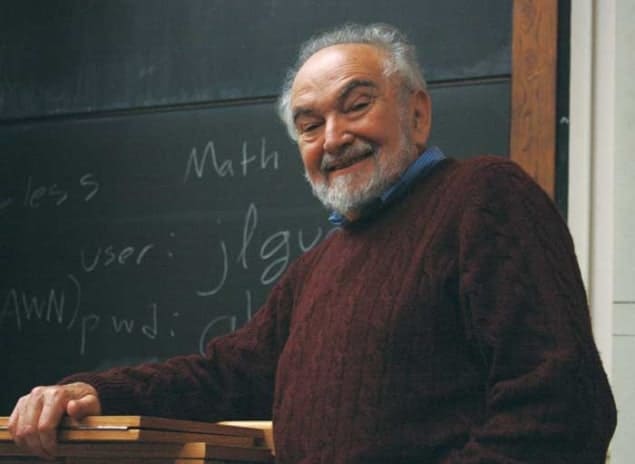Robert P Crease attends a meeting that’s extraordinary for its diversity, longevity, impact and, above all, the character of its organizer

Just as it had on the previous 115 occasions, the event opened with a bell carried by Joel Lebowitz. The 86-year-old physicist, often fondly called “the soul of statistical mechanics”, strode through the lobby of the Hill Center at Rutgers University’s Busch campus in New Jersey, clanging the bell to summon the animated coffee drinkers to the lecture hall. The 116th Statistical Mechanics Conference, held on 16–18 December last year, was about to begin.
Lebowitz’s biannual conferences are remarkable not only for their longevity – they have run since 1959 – but also for their egalitarianism and diversity. What’s more, the meetings, along with the Journal of Statistical Physics that Lebowitz has edited for the past 40 years, have helped the field of statistical mechanics to survive the forces threatening to fragment it into subfields.
Lebowitz: a life
Born in 1930 in a small town in what was then Czechoslovakia, Lebowitz’s native tongue was Yiddish. Life was tough in a Jewish community in this part of the world, but grew grimmer after the German occupation during the Second World War. Lebowitz’s family was sent to Auschwitz; only Joel – then aged 15 – survived. Thanks to a project to help orphaned children headed by Eleanor Roosevelt, Lebowitz obtained a visa to the US. He graduated from Brooklyn College in 1952, and was introduced to statistical mechanics, getting his PhD in physics from Syracuse University in 1956.
Outgoing and unflappable, Lebowitz readily collected friends. One was an artist and teacher named Kate Millett, who later became a famous feminist author. In her 1974 memoir Flying, Millett refers to Lebowitz under the pseudonym Jacob, describing him as “a charming Slavic soul with an insatiable taste for women and a tattoo on his arm from Auschwitz”.
In 1959, while at Stevens University of Technology in New Jersey, Lebowitz hosted his first informal conference on statistical mechanics. It was well received; the only alternatives, he told me at the most recent event, were formal conferences. Lebowitz continued the meetings, twice-yearly in May and December, after moving to Yeshiva University in Manhattan in the autumn of 1959. Talks were limited to five minutes and anyone who wanted could give one.
“Joel’s conferences were no-frills, geared for locals and on a single day,” recalls Pierre Hohenberg, a physicist then at Bell Labs. “You took the subway, no accommodation, no invited speakers, no Vugraphs [plastic sheets on which one could print or write and display with the aid of an overhead projector] and no food. They brought together a broad cross-section of the community and were how you kept up on the field.” Between 50 and 100 people would attend in the early years.
In 1977 Lebowitz moved to Rutgers. Many regular attendees were horrified: Rutgers was in the New Jersey countryside, you needed a car to get there and you had to stay overnight in a dilapidated hotel. Afraid the conferences would lose either their informal character or their audience, Hohenberg and others lobbied to continue the conferences at Yeshiva. Instead, Lebowitz rethought it.
He added invited speakers and celebrations of senior leaders in the field. If people stayed over, it might as well be a two-day (eventually three-day) conference. Amenities included meals and musical events. Finally, he flirted with formality by allowing Rutgers attendees to use Vugraphs. “That was a big ideological transition,” Hohenberg told me.
But Lebowitz continued to ensure that the conferences reflected the field’s diversity. At the start of his career, statistical mechanics was mainly concerned with effects on equilibrium processes in microscopic systems and scientists had only a data-driven grasp of phase transitions. The 1970s development of the renormalization group supplied a physical/mathematical understanding of phase transitions and scaling, which strengthened the difference between the mathematical side of statistical mechanics – involving exactly solvable models – and its physical side, allied with experimentation. The renormalization group also provided calculational techniques for scaling non-equilibrium systems that helped give statistical mechanics a broader range of applications. Lebowitz’s inclusive conferences embraced a spectrum of them.
At the December 2016 meeting, for instance, invited talks were given on statistical mechanics-related aspects of earthquakes, superconductors, liquid crystals, swimming particles, number theory, HIV, quantum mechanics and nacre – the beautiful iridescent material on the inside of certain molluscs. The spirit of the original Yeshiva format was retained in a morning session of five-minute talks on the behaviour of everything from electrons to microbes. As always, anyone who wanted to could give one of these talks, as long as you didn’t use Vugraphs or PowerPoint and erased the blackboard afterwards.
Lebowitz introduced each speaker, asked pointed questions and when speakers exceeded the allotted time, stood up and smiled until his genially expressed moral authority brought them to a halt. “It’s a one-man show, yet democratic and egalitarian,” Nihat Berker, an emeritus professor at the Massachusetts Institute of Technology, told me. “You don’t often see that.”
One talk is always devoted to human rights; this time Lebowitz gave it himself. “These are not good days for human rights,” he warned, mentioning recent cases involving individuals in Iran, the US, Egypt, China, Pakistan, Saudi Arabia and Turkey.
The critical point
Lebowitz’s meetings are ideal for our modern world, where researchers want to communicate their results and learn new ones – fast. Indeed, the standard scientific-conference format of concurrent sessions of PowerPoint-driven papers seems to me obsolete. Joel’s conference offers one successful alternative; the Gordon conferences, which have many imitators, are another. These reveal not only the continuing value of conferences in an electronic age but also the importance of leadership for creating a truly effective meeting.



